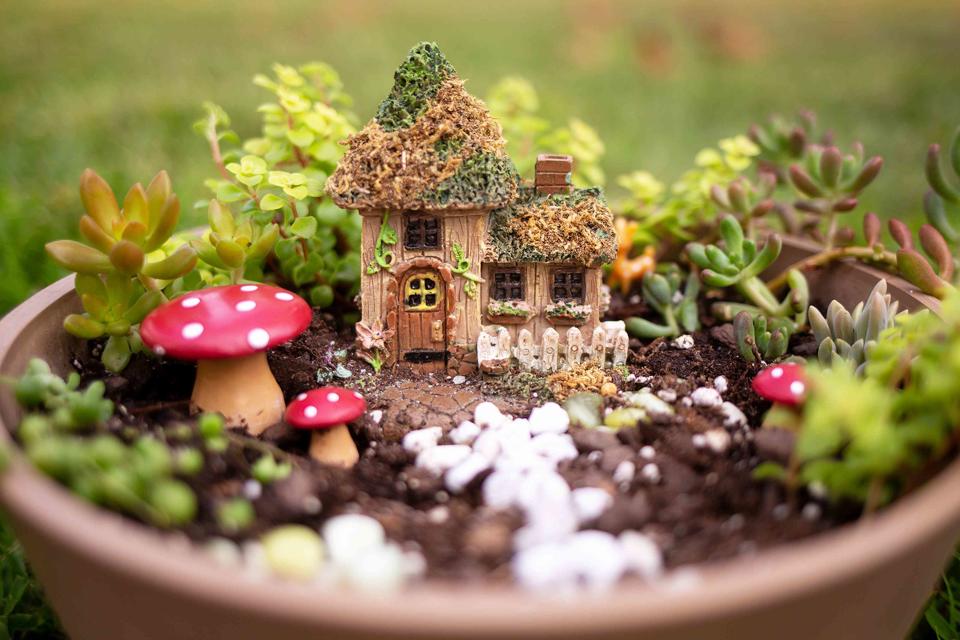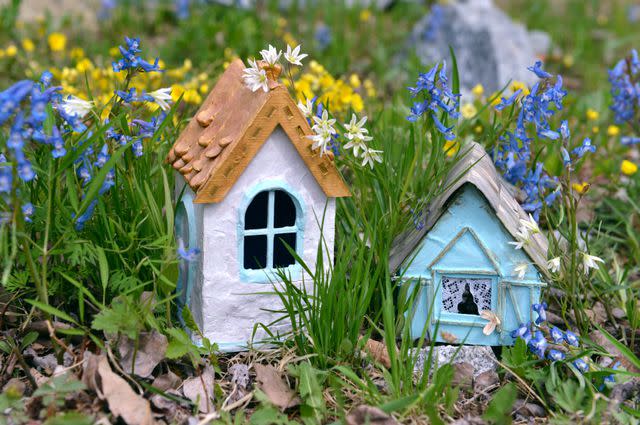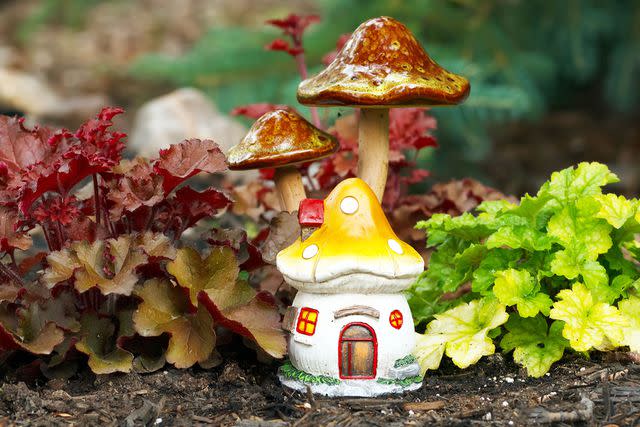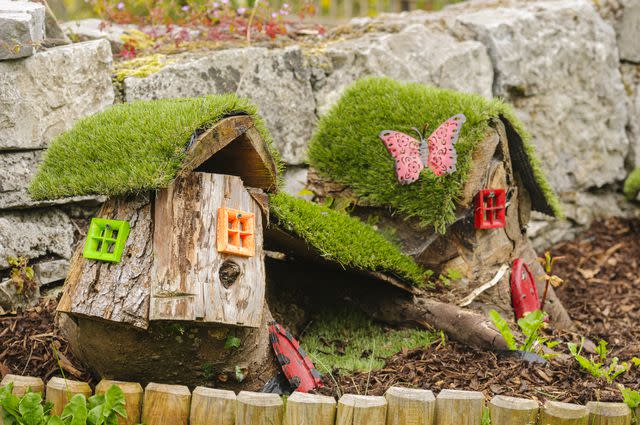How to Create an Enchanting Fairy Garden, Complete With Miniature Plants and Accessories
Embrace this stress-reducing hobby—and add a custom work of art to your garden.

carlofranco / Getty Images
The miniature world of fairy gardens is filled with delightful details, from tiny fairy figurines to furniture carefully woven from leaves and sticks. These tiny, intricate scenes have a basis in folklore, and provide a whimsical and imaginative accent to your indoor or outdoor gardens.
Build your own fairy garden using found containers or in a shady outdoor spot; add tiny plants and flowers; and finish it with petite accessories to create an enchanting scene on a pocket-sized scale.
Meet Our Expert
Gina Chung of Fairy Homes and Gardens
Julie Bawden Davis, author of Fairy Gardening: Creating Your Own Magical Miniature Garden
Related: 11 Garden Trends to Try in 2024, From Sensory Gardens to Food Forests
What Is a Fairy Garden?
Fairy gardens are collections of miniatures—often including figures, furniture, and live plants—with a rich foundation in Germanic and Celtic folklore. "Fairy gardens are gardens designed to lure fairies," says Gina Chung of Fairy Homes and Gardens. "The belief is that fairies can be either mischievous or good, bringing luck, health, and prosperity. If you want to attract good fairies, you have to create a welcoming place for them."
But even gardeners and hobbyists who shy away from folklore appreciate the charm of these tiny setups. "The concept of a fairy garden is to create a miniature garden with fairy or fairylike inhabitants that results in a captivating work of horticultural art," says Julie Bawden Davis, author of Fairy Gardening: Creating Your Own Magical Miniature Garden.
Creating pint-sized scenes helps both experienced and amateur gardeners perfect their planting skills while providing an outlet for stress relief. "It's a great way to destress, as handling the soil, plants, figurines, and other natural materials helps regulate the senses," says Chung. The teeny-tiny pieces of these fairy dream worlds also remind many adults of whimsical childhood play. "There is something about creating a miniature horticultural environment that takes one back to more carefree times," says Davis. "It’s hard to be stressed about life's challenges when you’re planting a miniature tree and positioning a fairy and her duck friends in your mini garden."

VeraPetruk / Getty Images
Choosing a Fairy Garden Theme
Choosing a theme for the design of your fairy garden can help you narrow down the key elements you need before you begin building. "While starting with a theme isn’t necessarily a requirement, doing so is highly recommended because a theme keeps you on track when you are planning, planting, and decorating your garden with accessories," says Davis. "It also provides an overall cohesive look that tells a story to onlookers—which is one of the keys of creating a captivating fairy garden."
Both experts agree that when considering a fairy garden theme, "the sky is the limit." Woodland setups, villages, and cottages are a popular starting point; more elaborate ideas, says Davis, include "beachside scenes, winter fairyland snow scenes for the holidays, birthday and tea party scenes straight out of Alice in Wonderland, farmland fairy gardens, and even mermaid gardens." Mermaids aren't the only fantasy friends to join the fairies, either, says Chung, who notes that elves, trolls, gnomes, and pixies are other frequent garden-scene guests.
Related: 25 Creative Container Garden Ideas to Enhance Your Outdoor Space
Types of Plants Suitable for Fairy Gardens
Greenery provides a lush complement to your other fairy garden accessories and bolsters the overall effect of your scene. "Dwarf and miniature plants are ideal as they will look more to scale with your accessories as a whole," says Chung. "Herbs, succulents, and various ground cover plants are also great choices." If you aren't sure exactly which plants you want in your garden, default to those native to your landscape and climate; Chung also has had customers opt for faux plants. "They can make magical seasonal displays on mantlepieces and centerpieces on dining tables," she says.

Anna Richard / Getty Images
Before You Start
Spend some time sketching out the basics of your garden before you begin building. "A captivating fairy garden shows a story unfolding," says Davis. "For instance, a fairy seated on a bench having a conversation with her pet kitty or an elf taking a snooze next to a pile of coins he has dug up from a treasure trove. It’s a good idea to keep this in mind when decorating the fairy garden."
Location
Fairy gardens work in both interior and exterior locations. "Indoors, fairy gardens can be made in terrariums, bowls, old jewelry boxes, or any small container that can be easily taken in and out," says Chung. "Outdoors, they can be made around trees, next to stumps, under bushes, or any partially hidden spots using in-ground plants."
Containers
If you choose to set up your garden in a container—whether it's a teapot on your windowsill or a wheelbarrow by your rose bush—Davis recommends one with both a depth and a diameter of 8 to 12 inches; drainage holes are also essential. "The shape doesn’t matter—what does is that you have enough root depth," she says. This will determine exactly which plants you can include in your fairy garden. "You also need true miniature plants that won’t outgrow the container," she says.
Related: The 10 Best Plants to Grow in Your Container Garden
Accessories
Fairy garden accessories can be handmade or store-bought. "Fairy gardeners can create their own DIY fairy homes and accessories by finding interesting stones, twigs, leaves, flowers, and trinkets outside in nature and around the house,” says Chung. Hobbyists will twist and shape these found items into tiny chairs, tables, sofas, and other minuscule pieces. If you choose to purchase small-scale items, you'll find everything from fairy figures and their tiny pets to birdbaths and fencing, says Davis—all of which add to the overall effect.

Stephen Barnes / Getty Images
Materials for a Fairy Garden
Part of the appeal of a fairy garden is how you can embellish, tweak, and change your story as you expand your setup. Before you begin, though, start with these basic supplies:
Container
Nutrient-rich potting soil
Gravel or rocks for drainage
Garden tools
Small plants
Figures and accessories
Pebbles, leaves, moss, and other natural accents
Instructions for Building a Fairy Garden
Chung recommends the following steps for building a fairy garden:
Choose an outdoor or indoor location for your garden, and select a container.
Based on the size of your container and its light exposure, choose plants and flowers.
Gather the fairies, figures, and other accessories you'd like to include.
Map out the layout of your garden. "Depending on the size of your container or space, you can create different scenes," says Chung. "It can be helpful to think of each scene as a different room in your fairy garden 'dollhouse.'"
Place drainage stones and soil into the container. "If planting outside, I recommend mixing in some peat moss or potting soil before planting," says Chung.
"Arrange—don't plant—your plants on top of the soil," says Chung. (This allows you to adjust the design before committing to a final layout.)
Moisten the soil, use a garden trowel to dig a small hole, and place your plants into the soil. Cover the roots and water after planting.
Add other landscape features, like ponds, paths, or walkways, using stones, sea glass, marbles, and other elements.
Place your figurines and other accessories into the garden. Maintain your garden by watering it gently and pruning or transplanting overgrown plants.
Read the original article on Martha Stewart.

